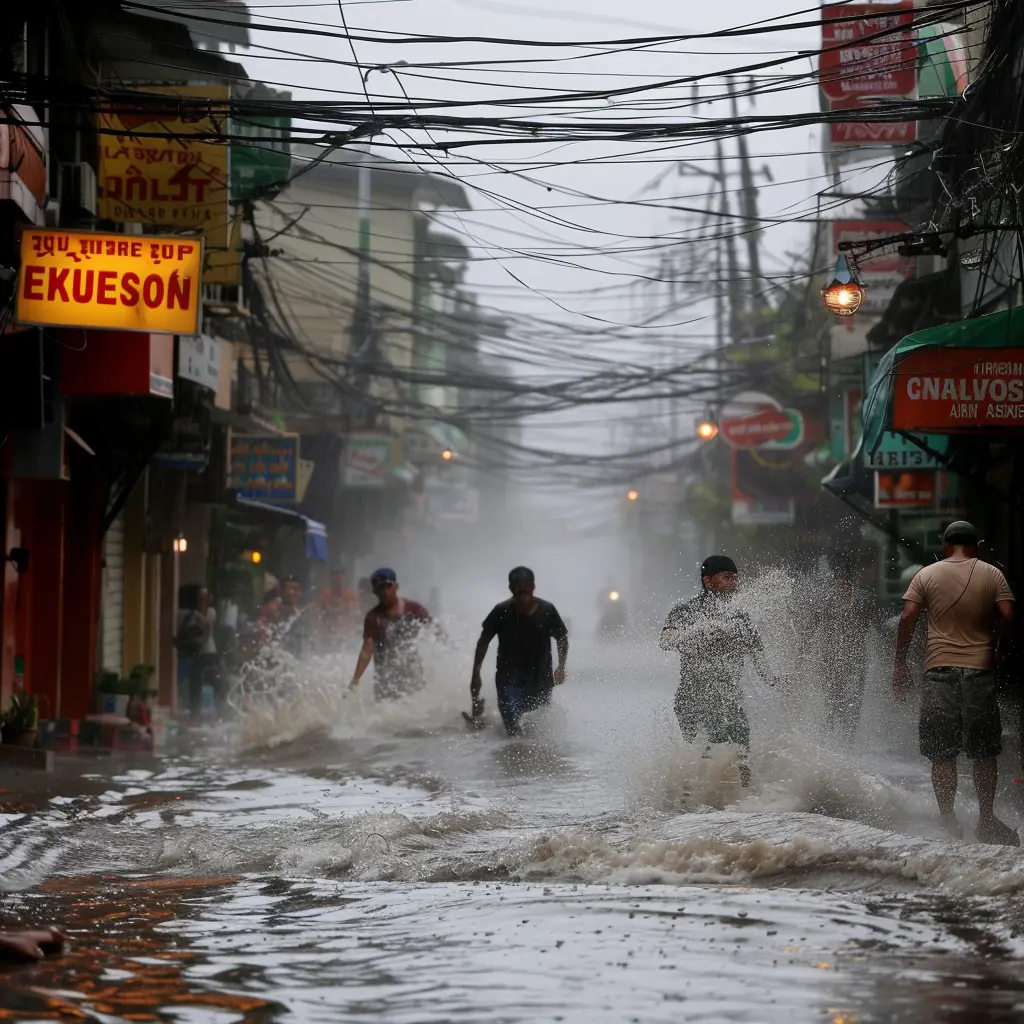Typhoon Carina July 2024: What You Need to Know



GCash extends assistance to users affected by Typhoon Carina
PAGASA said that “Carina” is forecast to make landfall over the northern portion of Taiwan Wednesday afternoon or early evening and exit the Philippine Area of Responsibility Wednesday night or Thursday morning. The typhoon is expected to continue moving northwestward to Taiwan at a speed of 25 kph, according to the state weather bureau.
The Southwest Monsoon, enhanced by Carina, will bring moderate to intense rainfall to western Luzon through July 26. Areas under Signal No. 1 are expected to have 39 to 61 kph wind speed, which causes minimal to minor threat to life and property.
Pagasa said the super typhoon is forecast to make landfall over the northern portion of Taiwan on Wednesday evening. Metro Manila, which was placed under a state of calamity on Wednesday due to the enhanced southwest monsoon, could still have moderate to heavy rain on Thursday.
Tropical Weather Advisories
Collaborative Efforts in Recovery
#CarinaPH continues to intensify, moves north to Taiwan
#WalangPasok: Class suspensions, Friday, July 26, 2024
Carina intensifies into a super typhoon; monsoon rain not yet over
- It is expected to make landfall over northern Taiwan this evening of July 24 or early morning of July 25.
- PAGASA has hoisted Tropical Cyclone Wind Signal No. 2 over Batanes, warning of gale-force winds ranging from 62 to 88 kph in the next 24 hours.
- Information based on data collected by Typhoon2000 (T2k) shall not be taken as official data.
- Metro Manila, which was placed under a state of calamity on Wednesday due to the enhanced southwest monsoon, could still have moderate to heavy rain on Thursday.
- Weather is expected to improve in the coming days, but the state weather bureau PAGASA reports heavy to intense rainfall is expected over the western portion of Luzon until 27 July.
- Signal No. 1 is still up at the Babuyan Islands, the northern portion of Cagayan, and the northern portion of Ilocos Norte.
On Friday, July 26, a significant weather event occurred as Typhoon Carina made its presence felt across several regions. As a result, local governments and educational authorities were compelled to implement class suspensions to ensure the safety of students and staff.
Weather information broadcasted and distributed by PAGASA remains as official data. Typhoon2000 (T2k) shall not be responsible for the private use and reliance of its weather information. PAGASA urged residents to monitor the latest Severe Weather Bulletin from PAGASA every six hours and stay updated with hourly forecasts. PAGASA advised residents to prepare for power outages, secure fishing boats, and elevate household items to prevent flood damage.
Carina did not make landfall in the Philippines but still brought rain and strong winds due to its size. Major river basins are closely monitored, which include the Pampanga and Agno in Central Luzon, the Cagayan River basin, and the NCR/Pasig/Marikina/Laguna de Bay River basin.
As of 4 PM, a post by a news agency said that the Marikina River’s water level has reached 20.6 meters, prompting forced evacuation in areas expected to be affected. As a comparison, TY Ondoy (Ketsana) in 2009 brought rains that raised the river’s water levels to 23 meters at peak. RSI NGD Group is actively collaborating with local authorities, NGOs, and international agencies to support Typhoon Carina’s recovery efforts.
The decision for class suspensions was influenced by various factors including wind speeds, rainfall intensity, and flooding risks associated with the typhoon’s trajectory. Authorities closely monitored the situation, prioritizing public safety during these adverse weather conditions.
In many areas, schools announced suspensions early in the day to allow parents to make necessary arrangements for their children. These announcements came through various channels such as official government websites, social media platforms, and local news outlets to reach a broader audience efficiently.
- Students in affected municipalities were advised to stay indoors and avoid unnecessary travel. Educational institutions utilized this opportunity to remind families about emergency preparedness plans, encouraging them to have supplies ready in case of extended disruptions due to the typhoon.
- Further updates regarding Typhoon Carina indicated that the storm was expected to bring about heavy rains and potential landslides, particularly in mountainous regions. The combination of strong winds and saturated ground posed additional risks, prompting warnings from weather agencies about possible power outages and property damage.
- Local authorities set up response teams to monitor the situations in various communities. They coordinated efforts with disaster management agencies to provide timely assistance to those in need. Information hotlines were established for residents seeking guidance on typhoon readiness and safety measures.
- Schools that had previously suspended classes also began planning for recovery once the storm passed, assessing facilities for any damage and ensuring that students could return to a safe learning environment. The impact of Typhoon Carina on school operations would likely lead to adjustments in academic schedules as well.
- As the day progressed, updates continued to flow in regarding the storm’s path and intensity. Emergency broadcasts kept the public informed about evacuation orders in high-risk areas, further highlighting the importance of adhering to safety protocols during such natural disasters.
Overall, the class suspensions on July 26 served as a proactive measure to protect the community during the unpredictable nature of Typhoon Carina, emphasizing the commitment of local authorities to safeguard the well-being of their citizens.

In Pampanga, heavy rains, and severe flooding leave P52.9 million in agricultural losses
In Pampanga, the impact of Typhoon Carina has led to significant agricultural losses due to heavy rains and severe flooding.
The province has reported a staggering P52.9 million in damages across various agricultural sectors.
Key details of the situation include:
- Severe weather conditions: Typhoon Carina brought unprecedented rainfall, resulting in rapidly rising water levels in rivers and irrigation systems.
- Flooded areas: Many towns and rural regions in Pampanga experienced extensive flooding, affecting farmlands and crops.
- Affected crops: Major crops such as rice, corn, and vegetables were severely impacted, leading to widespread crop loss for farmers.
- Livestock concerns: In addition to crop damage, there are reports of livestock being displaced or lost due to the inundation of pastures.
The provincial government and agricultural agencies are working to assess the full extent of the damage.
Emergency relief measures are being considered to support affected farmers and communities.
Additional observations related to the disaster include:
- Evacuation efforts: Local authorities have initiated evacuation plans for residents in high-risk areas to ensure their safety.
- Infrastructure damage: Roads and bridges may also be affected, hindering transportation and emergency response efforts.
- Weather monitoring: Continuous updates from weather agencies are crucial for guiding recovery efforts and future preparedness.
Looking ahead, recovery strategies will focus on:
- Financial assistance: Providing aid packages and loans to farmers for replanting and recovery.
- Restoration programs: Initiatives aimed at rehabilitating damaged infrastructure and restoring agricultural productivity.
- Long-term resilience: Implementing measures to enhance flood management and improve community readiness for future natural disasters.
The situation in Pampanga highlights the ongoing challenges faced by agricultural communities in the Philippines during typhoon season.
- Its landfall over northern Taiwan will trigger a weakening trend for the rest of the forecast period,” according to PAGASA.
- Minor to moderate impacts from strong winds are possible in areas under Wind Signal No. 2, while minimal to minor impacts are expected in areas under Wind Signal No. 1.
- As of 4 PM, a post by a news agency said that the Marikina River’s water level has reached 20.6 meters, prompting forced evacuation in areas expected to be affected.
- As of 4 p.m., the centre of the typhoon was located 380 km north of Itbayat, Batanes, with maximum sustained winds of up to 185 km/h near the centre and gusts reaching up to 230 km/h.
- A state of calamity has been declared in Metro Manila, the provinces of Batangas, Cavite, Pampanga and Bulacan, allowing local governments to fully access disaster funding.
- A gale warning is issued for Batanes, Babuyan Islands, and northern Cagayan.
As Typhoon Carina continues to affect the region, the focus remains on immediate relief efforts and long-term recovery planning.
UNICEF is concerned for children in parts of the Philippines affected by Typhoon Carina/Gaemi

UNICEF is deeply concerned for the welfare of children in the Philippines, particularly in regions affected by Typhoon Carina, also known as Typhoon Gaemi. This catastrophic event has caused significant disruption to the lives of many families, exacerbating existing vulnerabilities and compromising the safety and well-being of children.
The impact of Typhoon Carina is particularly severe in areas where infrastructure has been damaged, leaving communities struggling with access to essential services such as clean water, healthcare, and education.
- Children are among the most vulnerable during such natural disasters, facing not only immediate physical dangers but also long-term psychological and emotional challenges.
- UNICEF’s response includes assessing the needs of affected populations to provide timely and effective relief.
- This involves deploying teams for rapid assessments to gather data on the situation, focusing on the specific needs of children and their families.
- Emergency supplies, including food, water purification tablets, and hygiene kits, are being distributed to ensure that children have access to necessities.
- Moreover, UNICEF is prioritizing the establishment of safe spaces for children, allowing them to recover from the trauma of the disaster through play and psychosocial support.
- Safe learning environments are also a focal point, as schools may be damaged or repurposed for shelter. Efforts are underway to rehabilitate educational facilities and provide learning materials.
- In addition to immediate humanitarian response, UNICEF emphasizes the importance of protecting children from potential exploitation and abuse in the aftermath of the typhoon.
- This includes raising awareness among communities about the risks children face during emergencies and ensuring that child protection mechanisms are in place.
- Collaboration with local authorities and partners is crucial to ensure a coordinated response that addresses both immediate needs and longer-term recovery efforts.
- UNICEF advocates for the inclusion of children’s voices in recovery planning, recognizing that they should have a say in the rebuilding process to create a more resilient future.
- Through its ongoing efforts, UNICEF aims to ensure that the rights of every affected child are upheld, focusing on their right to survival, development, protection, and participation.
- The situation remains fluid, with continuous monitoring and adaptation of strategies based on the evolving needs of those impacted by Typhoon Carina.
- Support from the international community is vital; donations and resources are needed to sustain these initiatives and bring hope to children and families as they navigate the challenges posed by this disaster.
- UNICEF remains committed to advocating for the best interests of children in the Philippines, ensuring that they receive the care and support they need to overcome the adversities brought about by Typhoon Carina.
Carina intensifies into super typhoon Pagasa
Social Media

China vessels spotted off Manila Bay, El Nido
Recent reports have indicated the presence of Chinese vessels spotted off Manila Bay, raising concerns among local authorities and residents alike.
These sightings come amidst ongoing tensions in the South China Sea, where territorial disputes have been a source of contention between China and several Southeast Asian nations, including the Philippines.
The ships were observed engaging in activities that some believe could be related to resource exploration or fishing, which has often been a flashpoint for diplomatic conflicts in the region.

The Philippine government has issued statements regarding these sightings, emphasizing the need to monitor such maritime activities closely.
Officials have expressed their commitment to protecting the country’s sovereignty and ensuring the safety of local fishermen who depend on these waters for their livelihood.
In addition to the situation in Manila Bay, Typhoon Carina is also making headlines as it approaches the El Nido area in Palawan.
- The typhoon did not make landfall in the Philippines, but still affected parts of Northern Luzon and has been enhancing the southwest monsoon.
- The typhoon is expected to continue moving northwestward to Taiwan at a speed of 25 kph, according to the state weather bureau.
- It has maximum sustained winds of 140 km/h near the center, with gusts up to 170 km/h.
- Landfall there is expected between Wednesday evening and early Thursday morning, July 25, followed by Carina’s exit from PAR also on Thursday morning.
- Due to strong waves and winds, a fuel tanker carrying close to 1.4 million litres of fuel capsized off the coast of Bataan, north of Manila.
- The typhoon forced thousands of residents to evacuate their homes and disrupted daily life across affected regions.
This weather system has prompted the government and meteorological agencies to issue warnings and advisories for residents in affected areas.
- Typhoon Carina has been characterized by heavy rains and strong winds, posing risks of flooding and landslides, especially in mountainous regions.
- Local authorities are taking precautionary measures, including evacuating vulnerable communities and preparing emergency response teams to address potential disasters.
- The interplay between natural disasters like Typhoon Carina and geopolitical tensions in the region underscores the complexities faced by local communities.
- Residents are urged to stay updated on both the typhoon’s progress and any developments regarding the Chinese vessels to ensure their safety and well-being.
- The government’s multi-faceted approach aims to tackle immediate environmental challenges while also addressing long-term security concerns posed by external maritime activities.
- As situations evolve in both scenarios, collaboration between various government agencies and the public is crucial for effectively managing the impacts of Typhoon Carina and safeguarding the nation’s maritime interests.
Frequently Asked Questions
What signal number is Carina?
Tropical Cyclone Wind Signal (TCWS) No. 2 was raised over Batanes, where winds from 62 to 88 kph are expected in the next 24 hours.
What typhoon destroyed the Philippines?
Gaemi, called Carina in the Philippines, did not make landfall in that archipelago but enhanced its seasonal monsoon rains. They set off at least a dozen landslides and floods over five days, killing at least eight and displacing 600,000 people, the country’s disaster risk mitigation agency said.|}
What was the worst disaster in Philippine history?
Typhoon Haiyan, known locally as “Yolanda”, struck the Philippines on November 8, 2013, in what was reportedly the country’s worst-ever natural disaster. More than 8,000 people lost their lives and over 14 million inhabitants, including 5.9 million workers, were affected in some way by the storm.
Is the Carina typhoon still in the Philippines?
While Super Typhoon Carina no longer directly affects the country apart from Extreme Northern Luzon, many regions still experience heavy rainfall caused by the Southwest Monsoon (Habagat).
What is the name of the deadliest typhoon in the Philippines in 1881?
The 1881 Haiphong typhoon was a devastating typhoon that struck Haiphong, in northern Dai Nam (now Vietnam), and the northern part of the Captaincy General of the Philippines (now the Philippines) on October 8, 1881.|}






